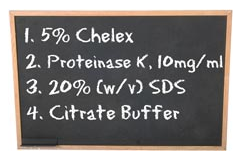Archival Notice
This is an archive page that is no longer being updated. It may contain outdated information and links may no longer function as originally intended.
Home | Glossary | Resources | Help | Contact Us | Course Map
Written formulations may be presented in different ways. For example, the instructions for preparation of the four reagents below use different styles to present the correct required information.
5% Chelex (w/v)
(Bio-Rad 143-2832 or equivalent):
Add 5 grams of Chelex 100 Resin to 100 ml of sterile deionized water. Properly label and date the container. Store at room temperature. Expires 1 year after preparation.
Proteinase K, 10 mg/ml (Sigma P-2308 or equivalent):
Dissolve 250 mg proteinase K in 25 ml deionized water. Aliquot and freeze. Properly label, date, and initial the container. If possible, individual aliquots may be labeled. Expires in approximately 3 years per manufacturer's recommendation.
20% (w/v) SDS:
1L bottle
800mL DI H2O
200g SDS (must be ultra pure – electrophoresis grade)
warm if necessary to dissolve
200ml DI H2O
store at RT (no expiration)
Citrate Buffer:
(0.1M Sodium citrate, pH 5.0)
1L bottle
800mL DI H2O
18.4g trisodium citrate dihydrate (Na3C6H5O5 · 2H2O)
adjust pH to 5.0 (takes about 6g citric acid monohydrate, C6H8O7 · H2O)
store at RT (no expiration)
Sample Excerpt from Log Book
The following generic format represents one method of documentation for recording information on specific reagents. For those reagents requiring quality control, this form may be modified to record the date of QC of the reagent and by whom.
|
Reagent |
Batch # |
Initials / Date |
Chemical / Lot#; Reagent / Batch# |
|
|
|
|
|
|
|
|
|
|
Sample Label for Reagent Containers
Alternatively, laboratory tape may be used to mark containers/aliquots with the appropriate information.
The QAS requires reagents to be labeled with the identity of the reagent, the date of preparation or expiration, and the identity of the individual preparing the reagent. Quality assurance and quality control will both be discussed at length in a subsequent module.
Additional Online Courses
- What Every First Responding Officer Should Know About DNA Evidence
- Collecting DNA Evidence at Property Crime Scenes
- DNA – A Prosecutor’s Practice Notebook
- Crime Scene and DNA Basics
- Laboratory Safety Programs
- DNA Amplification
- Population Genetics and Statistics
- Non-STR DNA Markers: SNPs, Y-STRs, LCN and mtDNA
- Firearms Examiner Training
- Forensic DNA Education for Law Enforcement Decisionmakers
- What Every Investigator and Evidence Technician Should Know About DNA Evidence
- Principles of Forensic DNA for Officers of the Court
- Law 101: Legal Guide for the Forensic Expert
- Laboratory Orientation and Testing of Body Fluids and Tissues
- DNA Extraction and Quantitation
- STR Data Analysis and Interpretation
- Communication Skills, Report Writing, and Courtroom Testimony
- Español for Law Enforcement
- Amplified DNA Product Separation for Forensic Analysts


